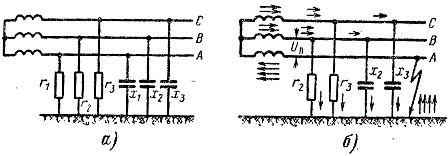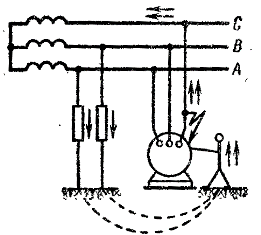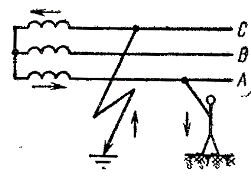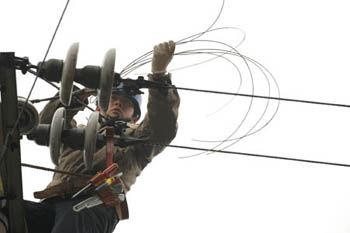How a three-phase current network with an isolated neutral works
Electric networks can work with grounded or isolated neutral of transformers and generators... 6, 10 and 35 kV networks work with isolated neutral of transformers. 660, 380 and 220 V networks can work with both isolated and grounded neutral. The most common four-wire networks 380/220 that comply with the requirements rules for electrical installation (PUE) must have a grounded neutral.
Consider networks with an isolated neutral... Figure 1a shows a diagram of such a three-phase current network. The winding is shown connected in star, but everything said below also applies to the case of connecting the secondary winding in delta.

Rice. 1. Diagram of a three-phase current network with isolated neutral (a). Network earthing with isolated neutral (b).
No matter how good the overall insulation of live parts of the network from earth, the conductors of the network are always connected to earth. This relationship is twofold.
1. The insulation of live parts has a certain resistance (or conductivity) with respect to ground, usually expressed in megohms.This means that a certain amount of current flows through the insulation of the wires and the ground. With good insulation, this current is very small.
Suppose, for example, that the voltage between the wire of one phase of the network and the ground is 220 V, and the insulation resistance of this wire, measured with a megohmmeter, is 0.5 MΩ. This means that the current to ground 220 from this phase is 220 / (0.5 x 1,000,000) = 0.00044 A or 0.44 mA. This current is called leakage current.
Conventionally, for greater clarity, on the diagram of the insulation resistance of three phases r1, r2, r3 are depicted in the form of resistances, each connected to one point of the wire. In fact, the leakage currents in a working network are distributed evenly along the entire length of the wires, in each section of the network they are closed through the ground, and their sum (geometric, that is, taking into account the phase shift) is zero.
2. A connection of the second type is formed by the capacitance of the network wires relative to the ground. What does it mean?
Each network wire and ground can be considered as two elongated capacitor plates… In overhead lines, the conductor and ground are like the plates of a capacitor, and the air between them is a dielectric. In cable lines, the capacitor plates are the cable core and metal sheath connected to ground, and the insulator is the insulation.
With alternating voltage, the change in the charges on the capacitors causes alternating currents to appear and flow through the capacitors. These so-called capacitive currents in a working network are evenly distributed along the length of the wires and in each individual section they are also closed through the ground. In fig.1, and the resistances of the capacitors of the three phases to ground x1, x2, x3 are conventionally shown connected each to one grid point. The greater the length of the network, the greater the leakage and capacitive currents.
Let's see what will happen in the one shown in figure 1 and the network, if an earth fault occurs in one of the phases (for example A), that is, the conductor of this phase will be connected to the earth through a relatively small resistance. Such a case is shown in figure 1, b. Since the resistance between the wire phase A and the ground is small, the leakage resistance and the capacitance to the ground of this phase are shunted by the grounding resistance. Now, under the influence of the line voltage of the network UB, the leakage currents and capacitive currents of two operating phases will pass through the point of failure and ground. Current paths are indicated by arrows in the figure.
The short circuit shown in Figure 1, b is called a single-phase earth fault, and the resulting fault current is called a single-phase current.
Now imagine that a single-phase short circuit due to insulation damage has occurred not directly to the ground, but to the body of some electrical receiver — an electric motor, an electrical apparatus, or to a metal structure on which electrical wires are laid (Fig. 2). Such a closure is called a case short circuit. If at the same time the housing of the electrical receiver or the structure is not connected to the ground, they acquire the potential of the network phase or close to it.

Rice. 2. Short to frame in network with isolated neutral
Touching the body is the same as touching the phase.A closed circuit is formed through the human body, the shoes, the floor, the ground, the leakage resistance and the capacitance of the usable phases (for simplicity, the capacitive resistances are not shown in Fig. 2).
The current in this short circuit depends on its resistance and can seriously injure or kill a person.

Rice. 3. A person touches a wire in a network with an isolated neutral in the presence of earth in the network
From what has been said, it follows that in order for the current to pass through the ground, it is necessary to have a closed circuit (sometimes it is imagined that the current "goes to the ground" is not true). In networks with isolated neutral voltage up to 1000 V, leakage and capacitive currents are usually small. They depend on the condition of the insulation and the length of the network. Even in an extensive network, they are within a few amps and less. Therefore, these currents are usually insufficient to melt fuses or break the connection circuit breakers.
At voltages above 1000 V, capacitive currents are of primary importance; they can reach several tens of amperes (if their compensation is not provided). However, in these networks, tripping of faulted sections during single-phase faults is usually not used in order not to create interruptions in the supply.
Therefore, in a network with an isolated neutral, in the presence of a single-phase short circuit (which is signaled by insulation control devices), the electrical receivers continue to work. This is possible because in the case of a single-phase short circuit, the line voltage (phase to phase) does not change and all electrical receivers receive power without interruption.But in the case of a single-phase fault in a network with an isolated neutral, the voltages of the undamaged phases with respect to the ground increase to linear and this contributes to the appearance of a second earth fault in another phase. The resulting double ground fault poses a serious danger to people. Therefore, any network with a single-phase short circuit in it should be considered emergency, since the general security conditions in such a network condition deteriorate sharply.
So the presence of "land" increases the danger electric shock when touching live parts. This can be seen, for example, from figure 3, which shows the passage of the fault current when accidentally touching the current-carrying conductor of phase A and an unrepaired "grounding" in phase C. In this case, one is under the influence of the line voltage of the network. Therefore, single-phase earth or frame faults must be rectified as soon as possible.

